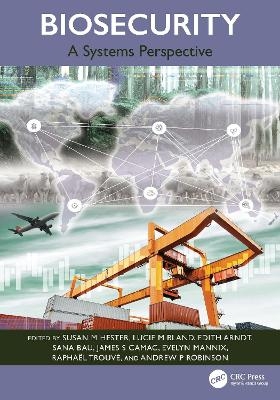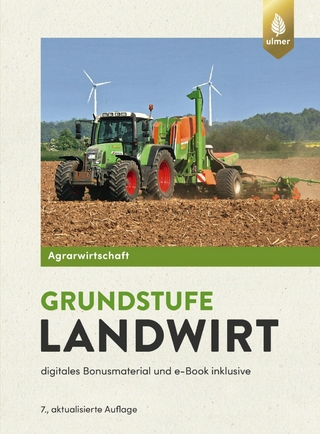
Biosecurity
CRC Press (Verlag)
978-1-032-18169-1 (ISBN)
1) This book uses a broad definition of biosecurity rather than solely focusing on plant health, animal health, security, or one step of the biosecurity system (e.g. surveillance). As such, this book is a one-stop-shop for readers interested in all aspects of biosecurity.
2) The content and language are accessible to a wide range of audiences, including generalist scientists, biosecurity practitioners and graduate students. More complex content is introduced in standalone boxes or chapters.
3) The book follows a clear, simple structure within and among chapters (i.e. following the structure of the biosecurity system), making it a preferred option for graduate students.
4) This book introduces novel cross-cutting themes, such as the importance of economic efficiency and institutional and social factors, going beyond the traditional science-based approach to biosecurity.
5) Written in partnership with government agency practitioners, this book uses on-the-ground case studies to demonstrate how biosecurity principles are applied in practice.
6) The book addresses challenges common to regulators in general, namely efficient regulation in uncertain and rapidly changing environments with multiple stakeholders who have — at times — conflicting priorities.
Susan M Hester Susan M Hester is deputy CEO of the Centre of Excellence for Biosecurity Risk Analysis (CEBRA) at the University of Melbourne, and Associate Professor the UNE Business School at the University of New England. She has a PhD in Agricultural Economics from the University of New England and an Honours degree in Economics from the University of Western Australia. Susan is an applied economist and has worked almost exclusively on issues related to invasive-species management since 2002. This has largely been via her role as a Chief Investigator with CEBRA, commencing in 2009. Recent projects have involved: re-evaluating management of European wasp using biocontrol agents; understanding the value of passive surveillance, and introducing incentive-compatible policies into the Australian biosecurity system in order to maximise value for money from biosecurity budgets. Lucie M Bland Lucie is an accomplished animal biologist. She completed a BA (Hons) in Biological Sciences from the University of Oxford, and a PhD in Ecology & Evolution from Imperial College London and London Zoo. Lucie’s research involves increasing knowledge about zoo animal biology, management, and conservation, and she also investigates the role of the wildlife trade in spreading zoonotic diseases. Lucie is also a natural health practitioner and animal lover. Edith Arndt Dr Edith Arndt is a research fellow specialising in biosecurity at the Centre of Excellence for Biosecurity Risk Analysis (CEBRA) at the University of Melbourne. She earned her master’s degree from the University of Vienna, and later obtained her PhD from the University of Melbourne. Within CEBRA, she engages in various biosecurity-related research projects through a collaborative co-production model alongside research partners at the Australian Government Department of Agriculture, Fisheries and Forestry. Her prior projects have encompassed a wide array of topics, including the development of an evaluation framework for Australia’s national biosecurity system, the examination of factors influencing marine vessel biofouling and its prevention and management, as well as the optimisation of resource allocation for border biosecurity risk controls. Before joining CEBRA, Edith worked within the public service sector at the state government level for nine years. Her responsibilities included monitoring, evaluation, and reporting; fire severity mapping; and database development. She has an interest in the interface between research and policy, and she actively engages in outreach activities aimed at inspiring high school students to pursue careers in the field of science. Sana Bau Sana is a researcher in decision science with a special interest in the use of science in environmental policy and practice. Sana has a BSc from the University of Otago and a Master of Environment at the University of Melbourne and is completing a PhD at the University of Melbourne. Sana’s other pursuits include web content creation and communications, lecturing in environmental risk assessment, and fashion and textiles. Nathaniel J Bloomfield Nathaniel J. Bloomfield is currently a research fellow at the Centre of Excellence for Biosecurity Risk Analysis, working on solving biosecurity challenges using the latest deep learning and AI approaches. They received their honours degree from the Australian National University with a university medal, and worked for several years at the Australian Bureau of Agricultural and Resource Economics and Sciences as a research officer, applying mathematical models to address biosecurity risks. They are currently undertaking a PhD at the University of Melbourne, with the Melbourne Centre for Data Science. James S Camac James is a Senior Research Fellow and Chief Investigator within the Centre of Excellence for Biosecurity Risk Analysis (CEBRA). As a trained quantitative and applied ecologist he has extensive experience in field ecology, long-term ecological monitoring, experimental design, ecological statistics, reproducible data science, biosecurity risk analysis and project management. His research tackles problems in two broad areas: understanding and forecasting changes in biodiversity, especially under climate change and changing fire regimes; and enhancing post-border surveillance networks to protect Australia’s environmental, social and economic values from exotic pests and diseases. Raphael Trouvé Raphael is a research fellow in forest ecology and statistical modelling at the University of Melbourne. He received a master and PhD in forest sciences from AgroParisTech. Raphael develops and applies quantitative methods to solve environmental problems, with applications to forest conservation and management and biosecurity. Andrew P Robinson Andrew P Robinson is CEO of the Centre of Excellence for Biosecurity Risk Analysis (CEBRA), and Professor in applied statistics at the University of Melbourne. He has a PhD in Forestry and a Masters in Statistics from the University of Minnesota, and has published four books, ninety research articles, and fifty ACERA/CEBRA technical reports on various aspects of risk analysis and biosecurity. He is an elected member of the International Statistical Institute. He joined the University of Melbourne in 2005 from the University of Idaho, where he was associate professor in forest inventory and forest biometrics. Andrew spends much of his time thinking about biosecurity at national borders, including analyzing inspection and interception data using statistical tools, designing and trialling inspection surveillance systems, developing metrics by which regulatory inspectorates can assess their performance, and discussing all of the above with, and indeed at, interested parties.
Introductory chapters
Foreword
1. Introduction
2. Biosecurity systems and international regulations
Summary
Introduction
International regulations for biosecurity
Biosecurity activities
Biosecurity as a complex system
In a nutshell
References
Section 1 Pre-border
3. Anticipate: Assessing biosecurity risks pre-border
Introduction
Risk assessment and risk analysis
Risk analysis and international trade
Qualitative and semi-quantitative risk assessment protocols
Common issues with qualitative and semi-quantitative risk assessment protocols
Quantitative estimation of likelihoods and consequences
Discussion
In a nutshell
References
4. Prevent: Aligning border surveillance with pre-border intervention
Introduction
Regulatory models for biosecurity interventions
Economic implications of regulatory models
Operationalising risk-based and incentive regulation
Discussion
In a nutshell
References
Section 2 Border
5. Screen: Designing sampling schemes for border inspection
Introduction
Design-based inference
Enhanced sampling methodologies
Adaptive inspection schemes
Tolerating leakage
In a nutshell
References
Section 3 Post-border
6. Detect: Designing post-border surveillance schemes
Introduction
Objectives of post-border surveillance
Types of post-border surveillance
Practical considerations in post-border surveillance
Value for money in surveillance planning
In a nutshell
References
7. Prepare, respond and recover: Selecting immediate and long-term strategies to manage invasions
Introduction
Emergency response strategies
Long-term response strategies
Practical considerations for post-border responses
In a nutshell
References
Section 4 Whole of System
8. Incentives: Incorporating incentives into biosecurity policies and regulations
Introduction
Designing markets for biosecurity risk
Creating standalone incentives
In a nutshell
References
9. Resource allocation: Using economic principles to prioritise projects and allocate biosecurity budgets
Introduction
Information underpinning resource allocation
Resource allocation methods
Selecting a resource allocation method to achieve economic efficiency
Barriers and opportunities for cost-efficient resource allocation in biosecurity
In a nutshell
References
10. Monitoring, evaluation, and reporting: Assessing the performance of biosecurity programs
Introduction
Monitoring, evaluation, and reporting in the planning cycle
Elements of successful monitoring, evaluation, and reporting
In a nutshell
References
11. Research uptake: Improving knowledge management in biosecurity agencies
Introduction
Knowledge management in organisations
Barriers to research uptake in biosecurity
Opportunities to improve research uptake in biosecurity
Assessing and improving knowledge management with audits
In a nutshell
References
Section 5 Innovative methods
12. Elicit: Using structured elicitation in biosecurity
Introduction
Eliciting facts in biosecurity
Eliciting values in biosecurity
Discussion
In a nutshell
References
13. Profiling and automation
Introduction
Profiling basics
Profiling cargo consignments – a simulated example
Profiling airline passengers
Automation basics
Profiling and automation in practice
In a nutshell
References
14. Map: Creating maps of establishment potential
Introduction
Developing maps of establishment likelihood
Estimating biotic suitability
Developing a pragmatic establishment likelihood map for oriental fruit fly in Australia
In a nutshell
References
Section 6 Concluding chapters
15. Conclusion
| Erscheinungsdatum | 10.07.2024 |
|---|---|
| Reihe/Serie | A life skills manual |
| Zusatzinfo | 20 Tables, black and white; 26 Line drawings, color; 17 Line drawings, black and white; 4 Halftones, color; 30 Illustrations, color; 17 Illustrations, black and white |
| Verlagsort | London |
| Sprache | englisch |
| Maße | 178 x 254 mm |
| Gewicht | 453 g |
| Themenwelt | Schulbuch / Wörterbuch |
| Weitere Fachgebiete ► Land- / Forstwirtschaft / Fischerei | |
| ISBN-10 | 1-032-18169-9 / 1032181699 |
| ISBN-13 | 978-1-032-18169-1 / 9781032181691 |
| Zustand | Neuware |
| Haben Sie eine Frage zum Produkt? |
aus dem Bereich


